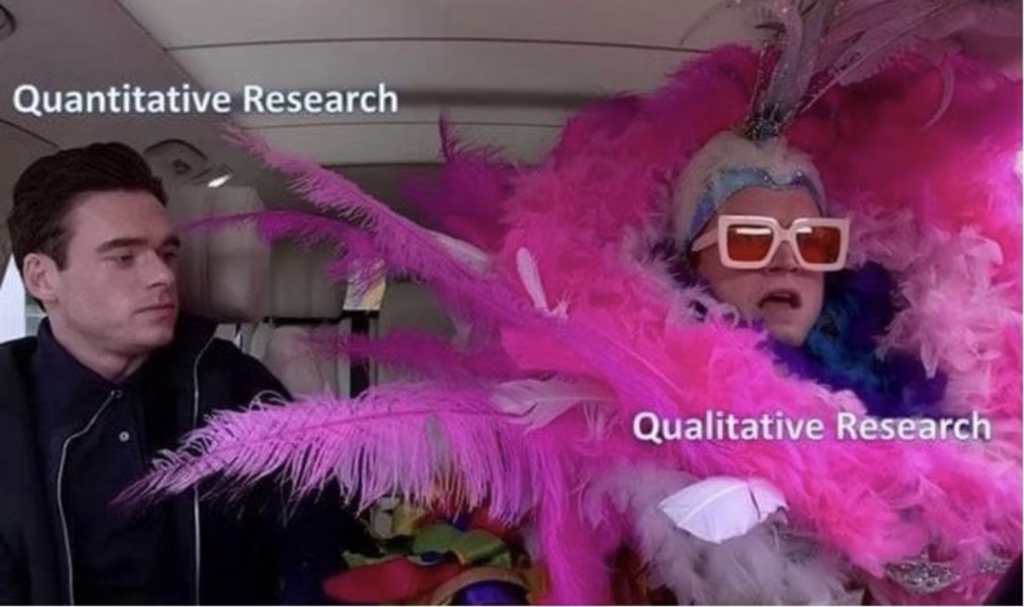You may have seen the meme, but now it’s time understand how qual and quant can be best friends.

Imagine you’re trying to follow a complex recipe. You meticulously weigh every ingredient (that’s your quantitative data – the “what” and “how much”) and follow the instructions. But without tasting it, smelling it, and understanding why certain ingredients work together (that’s your qualitative data – the “why” and “how”), you’d have a technically competent dish, that is missing the soul that makes it properly delicious.
The same goes for understanding your customers. In the world of market research, relying solely on one type of data brings science or art to the table. Neither is a bad thing, in fact they could both take you a long way, but the real magic happens when you bring the two together. In this case, quantitative and qualitative research.
Not always the most comfortable of bedfellows, quant and qual have at times been very separate disciplines in the market research world. Driven in very different ways, the two approaches pull in the same direction, and when combined can be much more than the sum of their parts. Basil and tomato, toffee and banana, tea and biscuits, to continue the cooking metaphor!
Quant – the big picture powerhouse

Think of quantitative research as your wide-angle lens. It’s about numbers, statistics, and measurable data. Surveys with closed-ended questions, large-scale polls, and analytics reports are its bread and butter. The benefits are clear –
Breadth and scale – you can gather data from a large sample size, allowing you to identify trends, patterns, and make statistically significant conclusions about your target market
Objectivity – numbers are numbers. They offer a relatively unbiased view of market sentiment and preferences
Measurable insights – you can track changes over time, benchmark against competitors, and quantify the impact of your strategies. Want to know if your customers prefer product A over product B? Quant’s your go-to.
However, quantitative data, while powerful, can sometimes feel a bit dry. It tells you what people are doing, but not necessarily why they’re doing it. It can tell you that 70% of your customers prefer product B, but it can’t tell you if it’s because of the packaging, the price or even the name of the product. This is where its qualitative counterpart steps in.
Qual – the “why” behind the “what”

Now, switch to your macro lens. Qualitative research is about diving deep, exploring nuances, and understanding human experiences, motivations, and perceptions. Think focus groups, in-depth interviews, observational studies, and open-ended survey questions. Here’s why it’s indispensable –
Depth and nuance – it uncovers the underlying reasons, emotions, and motivations driving consumer behaviour. Why did that 70% prefer product A? Qual will tell you about its perceived value or the emotional connection it evokes.
Rich insights – you get direct quotes, personal stories, and unexpected revelations that can spark truly innovative ideas
Exploratory power – it’s fantastic for exploring new concepts, understanding complex issues, and identifying unmet needs that quantitative data might not even hint at
Flexibility – researchers can adapt their questions in real-time based on participant responses, allowing for a more organic exploration of topics.
On its own, qualitative approaches can tell you a fascinating story, but it can’t tell you if the story is representative, or a niche opinion.
Blending for brilliance
The true superpower comes from combining the two approaches. Each method informs and enriches the other, leading to holistic and powerful insights.
Quant identifies the trends, qual explains them – quantitative data might show a drop in sales for a certain product. Qualitative research can then uncover why – perhaps shifting values, a new competitor, or a design flaw.
Qual uncovers hypotheses, quant validates them – during focus groups, participants might express a desire for a new feature. Quantitative surveys can be cross referenced to see if this desire is widespread across a larger audience.
A complete narrative – together, they paint a comprehensive picture. You get the statistically significant data and the rich human stories that make that data meaningful and actionable. This leads to more informed decision-making, better product development, and more effective marketing strategies.
So, the next time you’re planning your market research, don’t just pick a side, embrace the dynamic duo! Your brand, and your customers, will thank you for the truly holistic picture it delivers.
Want to know more about how BEAM combines qual and quant research? Read a case study on a project we rand for a UK soft drink challenger brand here
